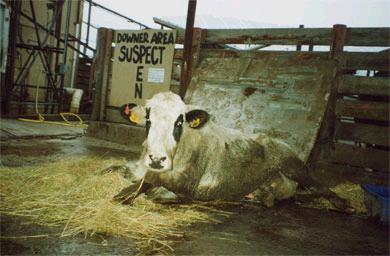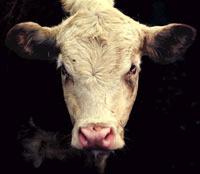Despite assurances to the contrary,
our food supply is not safe from Mad Cow Disease. The USDA, an agency intended to protect consumers, has been acting more
like a PR firm for the beef industry.
*Mad Cow Disease, or bovine spongiform encephalopathy (BSE), is caused when cattle
eat the brain matter of other cows, and is transmitted when they eat part of another infected animal.
*The disease
is spread to humans by eating the meat of infected animals. They may develop Creutzfeld-Jakob disease (CJD), which eats holes
in the brain, causeing memory loss, erratic behavior, loss of the ability to care for one's self and communicate, then death.
*CJD
IS ALWAYS FATAL!
*So far, more than 140 people in England have died from the disease, and bacause of the gap of time
between eating infected animals and showing signs of the disease, it is estimated that thousands more will die.
*Millions
of cattle in England, Scotland, Ireland, France, Belgium, and Italy have been incinerated, but they have not been able to
stop the epidemic.
*Few of the safeguards that have been adopted in Europe have been adopted in the U.S.
*Two
years ago, 200 sheep in Vermont were killed because they were suspected of having chronic wasting disease, an equivalant to
BSE. When infected sheep are fed to humans, they develop CJD, when they are fed to cattle cattle they develop BSE. Sheep are
still fed to cattle in the U.S.
*In May of 2003, an 8 year old cow in Alberta, Canada, was found with BSE. This cow
was killed, but many countries, including the U.S., banned the importation of Canadian beef. Canada lost $1 million a day
following the ban.
*On December 23, 2003, a downed dairy cow in Washington tested positive for BSE. The problem is
that she was slaughtered on December 9 and had already traveled through three processing plants and her body sent to multiple
Western states and Guam before it was discovered. It's hard to say who ate her, what will happen to them, or how many other
cows there are in the U.S. with the same affliction.
*Japan, Russia, Australia, Mexico, and many others have placed
a ban on U.S. beef.
*One reason the cow was discovered was because she was a dairy cow and was allowed to live longer
than most cows. Most cows are killed before they are 2, pigs before they are 6 months old, and chickens between 6 and 7 weeks.
There are generally no signs of BSE at this stage, but people can still develop CJD from the meat.
*The cow was also
a "downer", a term used to describe an animal to sick or injured to walk to slaughter. These animals were usually haled with
ropes or chains, beaten until they moved, or pushed with bulldozers into the slaughterhouse - or sold to renderers who fed
them to other cattle.
*According to the USDA, between 130,000 to 190,000 downed cattle are sent to processing each
year. A third are for human consumption. At least 200,000 become downed every year.
*Because of recent events, and
the public outcry caused by them, the USDA has issued a ban on the slaughter and sale of downed animals.
*Animal protection
organizations have lobbied for this for over a decade, and this is a great victory for the animals because it will force farmers
to treat the animals better so that they do not become downed in the first place.
The USDA admits that it tested only 20,000
cows (and no other animals) for BSE last year - out of 40 MILLION cows slaughtered, and 10 BILLION other animals slaughtered.
*Feeding
sheep and cattle to cows in the U.S. was not banned until 1997, and the government recently said that there was widespread
violation of the feeding regulation.
*Farmers can still feed cow's blood to cows (even though Mad Cow disease can be
transmitted through blood), and can still feed sheep and cows to pigs and chickens and pigs and chickens to one another and
to cows (even though the disease can spread through almost any species). All these practices have been banned in Europe.
*The
USDA wants us to believe that only certain parts of the animal, like the brain and the spinal cord can transmit the disease.
This is not true. Though the prions, the malformed proteins causing the disease, are in higher concentrations in these parts,
any part of the animal can spread the disease. And federal inspections found that much of our hamburger has brain matter and
spinal cord of cattle mixed in with it.
*This all came about because people wanted to save money by feeding the ground
up remains of one cow to another. It should have occurred to us that when we turned a naturally vegetarian species into a
carnivore and a cannibal, some unnatural things might happen.
*The problem became so widspread in Europe because they
attempted to deny the facts and conceal the truth. Right now our government is on a similar path, seeking to limit the damage
to the cattle industry while putting the public in jeopardy.
*There is no way to know if the meat you are eating may
have Mad Cow disease, if 10 years from now you will develop symptoms of the degenerative disease, and within months not be
able to care for yourself.
*The disease is also transmitted vertically, meaning that cows not only pass the disease
on to their young, but so do humans. Recently a pregnant woman in Japan was diagnosed with the disease, and when her baby
was born it tested positive for CJD.
*Perhaps this is nature's way of telling us that we shouldn't have been feedin
cows to cows, or that the human body was not meant to consume meant. Whatever it is, this problem is not going to go away,
it has been known in Europe for 18 years.
*The best way to avoid Mad Cow disease is to go vegetarian or vegan! Email
us or many other animal rights groups for a vegetarian starter kit.
*If you're not willing to do that just yet, organic
meat not only is more humane for the animals, but the animals aren't fed other animals, or pesticides or antibiotics.
*You
can also avoid beef or reduce your intake of beef, reducing your risk of eating infected animals.
|
 |
|

VIEW THE LINKS BELOW:
| go to the right of the page |

|
| Risks to Human Health: |

|
| Images: |

|
|
|